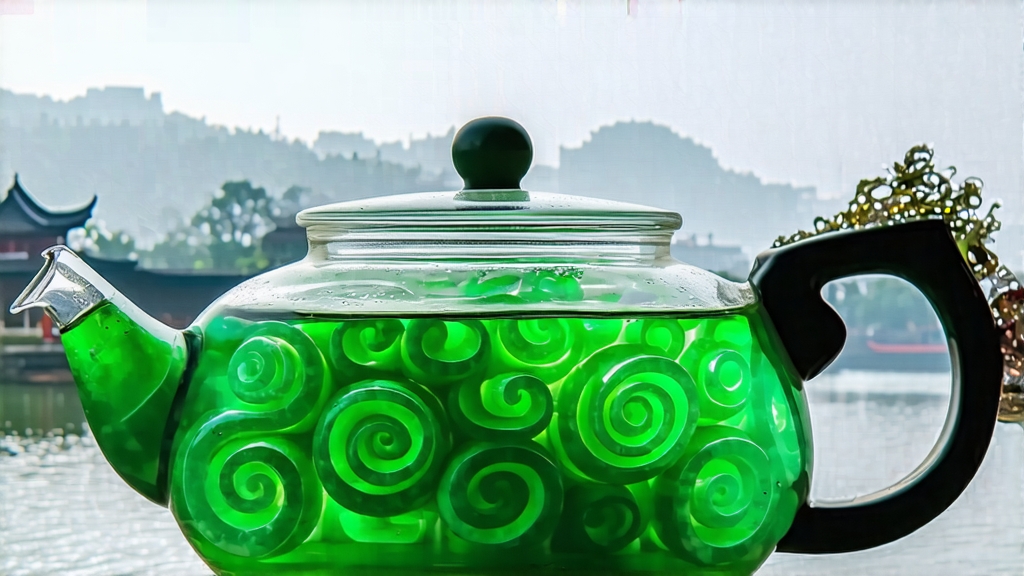
Biluochun, whose name translates literally to “Green Snail Spring,” is one of China’s ten most celebrated teas, yet it remains a delicate secret outside serious connoisseur circles. Grown in the mist-locked hills that rim eastern Lake Tai (Taihu) in Jiangsu Province, this tea is prized for its tiny, spiral-shaped leaves, an intoxicating orchid-and-fruit aroma, and a lingering sweetness so refined that the Qing-dynasty Emperor Kangxi is said to have renamed it “Green of Spring Snail” after its resemblance to tiny jade snails. For international drinkers accustomed to the vegetal punch of Japanese sencha or the chestnut notes of Longjing, Biluochun offers a softer, more floral gateway into the vast universe of Chinese green tea.
Historical whispers place Biluochun’s birth during the late Ming dynasty, around the 1640s, when tea growers in the Dongting mountain range began noticing that the highest bushes, often shrouded in lake mist, produced leaves of exceptional fragrance. Local monks first fired the leaves in small woks, rolling them by hand against the hot iron until each bud curled into a tight spiral. By the time Kangxi visited Suzhou in 1699, the tea had already earned the poetic nickname “Xia Sha Ren Xiang”—“scary fragrance”—because its perfume was said to startle unsuspecting scholars mid-sip. The emperor, charmed, bestowed the more elegant name we use today.
Strictly speaking, only leaf picked within the Dongting Dongshan and Xishan peninsulas can claim the protected geographical indication of “Original Biluochun.” Yet the market now recognizes three stylistic grades: Supreme, picked before the Qingming festival when only one tender bud and half-open leaf are taken; Fine, harvested before the Grain Rain period with one bud and one leaf; and Standard, gathered later in April when two leaves emerge. Each grade demands different withering times and firing temperatures, but all rely on the same cultivar—an indigenous small-leaf Camellia sinensis var. sinensis locally called “Xiao Ye Zhong,” whose low yield concentrates flavor.
Crafting Biluochun is a race against time and oxidation. Picking starts at dawn when dew still pearls on the buds; any delay risks enzymatic browning that would flatten the tea’s signature brightness. Leaves are spread in bamboo trays for no more than two hours, just long enough for surface moisture to evaporate while internal cells remain turgid. The critical “sha qing” (kill-green) step follows: leaves are tossed into woks heated to 180 °C, where they are hand-pressed, shaken, and flipped for precisely four to five minutes. Masters listen for the crackle that signals moisture dropping below 58 percent; the aroma shifts from grassy to ripe apricot at this tipping point. Immediately the leaves are rolled—first lightly to shape the curl, then vigorously to rupture cell walls and release aromatic oils. A final low-temperature drying at 60 °C for twenty minutes sets the spiral and locks in the orchid note. Throughout, the tea maker’s bare hands are the only tool; no brushes, no machines, just skin sensing the slightest change in texture.
To brew Biluochun properly, one must respect its fragility. Use a tall glass or a gaiwan of thin porcelain so the swirling leaves can be observed like green snails dancing in a clear pond. Water should be spring-soft and cooled to 75 °C; anything hotter scalds the buds, coaxing out bitter catechins instead of sweet amino acids. A common ratio is three grams—about a heaping teaspoon—to 150 milliliters of water. Pour the water along the vessel’s wall to avoid direct impact on the leaves, then pause for thirty seconds while the spirals slowly unfurl. The first infusion yields a pale champagne liquor with a faint jade rim; inhale gently and you may catch the scent of peach skin and narcissus. Subsequent steeps can last forty, sixty, and ninety seconds, each revealing a layered profile: first orchid, then lychee, finally a cool mineral note reminiscent of Taihu’s limestone shores.
Tasting Biluochun is best done in silence. Take a small sip, hold it on the tip of the tongue, and breathe through the nose; the retronasal passage amplifies the tea’s lactone compounds, creating an illusion of juicy loquat. Swallow slowly and notice how the throat responds: a great Biluochun leaves a cooling sensation,